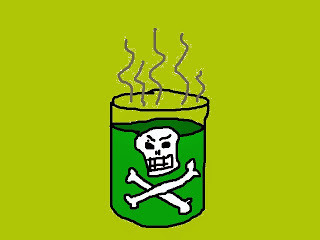Medical Mondays: Scent of a Poison

This is not about Dior's perfume.
Did you know that certain poisons have particular scents? Next time you need to write a poisoning scene, keep these in mind!
Fruity: Acetone (not in the concentrations you find in nail polish remover) has a slightly fruity odor.
What poisons ingested by a person would cause this smell: isopropyl alcohol (rubbing alcohol), ethanol (drinking alcohol), salicylates, and chloroform.
When you might have smelled it: Diabetics who have very high blood glucose levels produce a lot of acetone in their system and may smell like this. People on ketogenic diets (like the Atkins diet) may produce this scent. Also, it's a characteristic odor carried by someone who's intoxicated from alcohol.
Bitter Almonds: Cyanide. This is a classic description of the smell of cyanide gas and is a trope in murder scenes. Keep in mind that some cyanide gases are odorless. And about a third of the population is incapable of smelling it anyway. It's a genetic thing. And finally, before you write this into your story, remember that in order to sniff this scent on someone who was poisoned, there's have to be a LOT of cyanide in the air, which would be unlikely in surreptitious poisonings, FYI.
Oh geez. Does that mean my almonds are poisoned? No! Almonds consumed today are the "sweet" variety, which have no cyanide. The "bitter" variety does in fact contain about 4-9 mg of cyanide per nut, but they are not used as food.
Garlic: arsenic, organophosphates (used as insecticides, herbicides, and weapons of mass destruction), thallium (used to be used in stress tests), selenium, and phosphorus, and zinc phosphide (which is used as a rodenticide. Apparently it attracts rodents but turns off birds, dogs, cats, etc.)
Mothballs: paradichlorobenzene, naphthalene, camphor. All three are used in making mothballs. I made paradichlorobenzene in organic chemistry lab. Fun times! Camphor is what gives that cooling sensation in Vicks VapoRub and cooling gels. It's poisonous in large doses.
Kerosene: organophosphates, parathion (insecticides and acaricides--that's something that kills spiders and mites). Does anyone younger than age 25 even know what kerosene smells like? We used to have a kerosene heater at my house when I was a kid. It scared me witless.
Freshly Mown Hay: Ah, lovely scent. Too bad it's a sign of phosgene poisoning (a chemical weapon used in World War I)
Rotten Eggs: Hydrogen sulfide. Poisonous, corrosive, flammable and explosive. Basically, it's HELL. Also implicated as a cause of the Permian-Triassic extinction about 250 million years ago. Eep.
Wintergreen, or minty: Methyl Salicylate. I did a Medical Mondays on this one: (Wintergreen Party Tricks, Poison, and Ben Gay!)
Shoe Polish: Nitrobenzene. A compound that smells sort of nice and almost almond-y, used to mask bad odors in shoe polish, solvents, and floor polish. Highly toxic to the nervous system, absorbed through the skin, and a potent carcinogen.
Peanuts: Vacor, a rodenticide. Also goes by pyrinuron, and is no longer used in the US. Interestingly, it can kill insulin producing cells in the pancreas and cause Type I Diabetes.
Pear: Chloral hydrate, once used as a sedative gas. Some say it smells fruity, other describe it as "pungent."Still used a common chemical lab reagent.
Carrot or Parsnip: Water hemlock. The root and the oily liquid from it has this characteristic smell, which is no surprise since it's related to carrots. It's highly poisonous.
Disinfectant: Phenols and cresols. These compounds are found in a lot of places, like antiseptic throat sprays, Scotch Whisky, Sharpie markers, and Lysol spray. Here's a fun article, if you've time for it: "Why Does Scotch smell like Bandaids?" Phenols are corrosive and can cause burns and dermatitis.
Well, this post makes me want to sneeze. Here are some references, if you'd like to read on:
http://lifeinthefastlane.com/toxicology-conundrum-027/
http://tvtropes.org/pmwiki/pmwiki.php/Main/BitterAlmonds
http://www.fpnotebook.com/er/toxin/TxnIndcdOdrs.htm
Oh, and a huge shout-out to my old friend Dr. Wasserman, who pointed out on FB that the esteemed head Dr. Lewis Goldfrank--as in the renowned Goldfrank's Toxicologic Emergencies ) made a "Sniffing Bar" to help ER residents associate scents with certain toxic chemicals. Here is the PDF of the published study. So cool! (And, no, they didn't actually sniff real toxins, only smell-alike, safe substances.)
Have a great Monday and Happy December! Don't let this post turn you off from ordering that almond-milk mochachino!
Published on December 01, 2013 22:00
No comments have been added yet.



